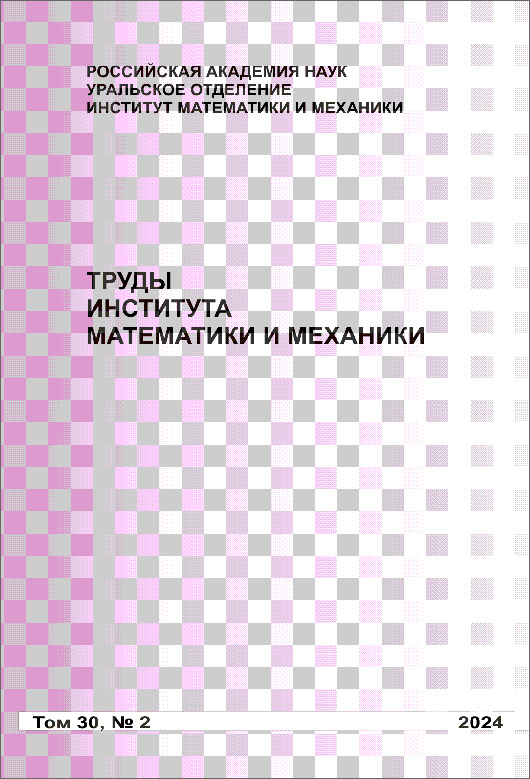|
Some Schurian association schemes related to Suzuki and Ree groups
L. Yu. Tsiovkina
Institute of Mathematics and Mechanics, Ural Branch of the Russian Academy of Sciences, Ekaterinburg
Abstract:
An association scheme is a pair $(\Omega,\mathcal{R})$ consisting of a finite set $\Omega$ and a set $\mathcal{R}=\{R_0,R_1\ldots, R_s\}$ of binary relations on $\Omega$ satisfying the following conditions: (1) $\mathcal{R}$ is a partition of the set $\Omega^2$; (2) $\{(x,x)\ |\ x\in \Omega\}\in \mathcal{R}$; (3) ${R_t}^T=\{(y,x)\ |\ (x,y)\in R_t\}\in {\mathcal R}$ for all $0\le t\le s$; (4) for all $0\le i,j,t\le s$, there exist constants $c_{ij}^t$ (called the intersection numbers of the scheme) such that $c_{ij}^t=|\{z\in \Omega| (x,z)\in R_i, (z,y)\in R_j\}|$ for any pair $(x,y)\in R_t$. An association scheme $(\Omega,\mathcal{R})$ is called Schurian if, for some permutation group on $\Omega$, the set of orbitals of this group on $\Omega$ coincides with $\mathcal{R}$. This work is devoted to the study of Schurian association schemes related to Suzuki groups $Sz(q)$ and Ree groups ${^2G}_2(q)$ with $q>3$ for which some graphs of their basic relations are antipodal distance-regular graphs of diameter 3. Assume that $G$ is one of the mentioned groups, $r=(q-1)_{2'}$, $B$ is a Borel subgroup of $G$, $U$ is a unipotent subgroup of $G$ contained in $B$, $K$ is a subgroup of $B$ with index $r$, $g$ is an involution in $G-B$, and $f$ is an element of order $r$ in $B\cap B^g$. Let $\Omega$ be the set of the right $K$-cosets of $G$, and put $h_i=f^i$ and $h_{r+i}=gf^i$ for all $i\in \{0,\ldots,r-1\}$. Denote by ${\mathcal{R}}$ the set $\{R_0,R_1,\ldots, R_{2r-1}\}$ of binary relations on $\Omega$ defined for each $t\in \{0,1,\ldots,2r-1\}$ by the rule: $(Kx,Ky)\in R_t$ if and only if $xy^{-1}$ is contained in the double coset $Kh_tK$. We prove that ${\mathcal X}=(\Omega, {\mathcal{R}})$ is a Schurian association scheme and its set of basic relations coincides with the set of orbitals of $G$ on $\Omega$. We find that the intersection number $c_{ij}^t$, where $0\le i,j,t\le 2r-1$, of the scheme ${\mathcal X}$ is $|U|$ if $t\le r-1$, $i,j\ge r$, and $j-i\equiv t \pmod r$; $(|U|-1)/r$ if $ i,j,t\ge r$; 1 if either $t\le r-1$, $i,j\le r-1$, and $ i+j\equiv t \pmod r$, or $i\le r-1$, $t,j\ge r$, and $ j-i\equiv t \pmod r$, or $t,i\ge r$, $j\le r-1$, and $ i+j\equiv t \pmod r$; and 0 in the remaining cases, where $|U|=q^2$ if $G=Sz(q)$ and $|U|=q^3$ if $G={^2G}_2(q)$. As a corollary, we find the structural parameters $m_{h_t}(h_i,h_j)=|\{Kx\in \Omega |\ Kx\subseteq Kh_i^{-1}Kh_t\cap Kh_jK\}|$ of the Hecke algebra $\mathbb{C}(K{\setminus}G/K)$ of $G$ with respect to $K$. Namely, we show that $m_{h_t}(h_i,h_j)$ is exactly the intersection number $c_{ij}^t$ of the scheme ${\mathcal X}$ for all $0\le i,j,t\le 2r-1$. By definition, the graph of the basic relation $R_t$ with $t\ge r$ of ${\mathcal X}$ is equivalent to the coset graph $\Gamma(G,K,Kh_tK)$ of $G$ with respect to $K$ and the element $h_t$ and, as is known, is an antipodal distance-regular graph of diameter 3 with intersection array $\{|U|,(|U|-1)(r-1)/r,1;1,(|U|-1)/r,|U|\}$. The latter fact was proved in the author's earlier paper, where we proposed a technique for studying the graphs $\Gamma(G,K,Kh_tK)$; the technique is based on analyzing the mutual distribution of the neighborhoods of vertices. In the present work, we prove the distance regularity of these graphs as a corollary of the properties of the scheme ${\mathcal X}$.
Keywords:
Schurian association scheme, distance-regular graph, antipodal graph.
Received: 05.09.2019
Revised: 23.10.2019
Accepted: 28.10.2019
Citation:
L. Yu. Tsiovkina, “Some Schurian association schemes related to Suzuki and Ree groups”, Trudy Inst. Mat. i Mekh. UrO RAN, 25, no. 4, 2019, 249–254
Linking options:
https://www.mathnet.ru/eng/timm1690 https://www.mathnet.ru/eng/timm/v25/i4/p249
|

| Statistics & downloads: |
| Abstract page: | 266 | | Full-text PDF : | 35 | | References: | 27 | | First page: | 4 |
|




 Contact us:
Contact us: Terms of Use
Terms of Use
 Registration to the website
Registration to the website Logotypes
Logotypes








 Citation in format
Citation in format 